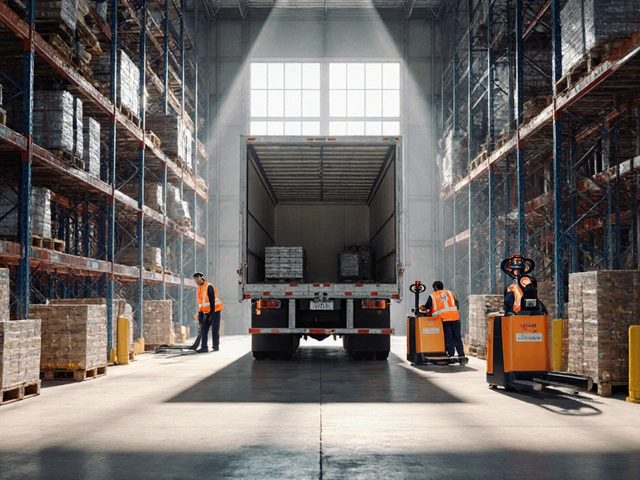Ever wondered how much supply chain software could set you back? It's not as straightforward as picking a tool off the shelf. Prices can swing from a few hundred to thousands of dollars, depending on several factors. Let's break down what you're actually paying for.
First off, the cost isn't just about the software itself. It's like buying a car; you're not only paying for the wheels and engine. You're investing in support, updates, and maybe even initial training sessions to get your team up to speed. All these extras can add up, so knowing what comes with your package is key.
Factors Affecting Cost
When diving into the costs of supply chain software, it's important to know what's driving these prices. The truth is, there are several factors at play, each influencing how your final invoice shapes up.
1. Complexity and Features
Think of software features like toppings on a pizza—the more you add, the more it costs. If you're looking for basic features like order tracking, the price will be lower. But start adding options like advanced analytics, forecasting, and integration capabilities, and the numbers start to climb.
2. Company Size and Needs
If you're managing a small business, your needs—and costs—are going to differ from those of a massive corporation. Small businesses might get by with a straightforward solution, while larger companies may need something robust that can handle massive inventories and multiple locations.
3. Deployment Type
Deployment can greatly affect costs. On-premise software often requires hefty upfront payments and maintenance fees. In contrast, cloud-based solutions typically involve lower initial costs but have recurring subscription fees that can accumulate over time.
4. Vendor Training and Support
Training your team on new software isn't free. Some vendors charge for this service, so it's wise to factor in these potential costs. Also, consider the level of support offered—24/7 support might come at a premium but could prove invaluable if issues arise.
5. Customizations
Every business has unique needs, and sometimes off-the-shelf solutions just don't cut it. Customizing software to fit your specific requirements is possible, but be prepared for the additional time and expense.
Understanding these factors will help you make a more informed decision when shopping for logistics software. Keeping these in mind helps align your needs with your budget, ensuring you get the best value without unpleasant surprises.
Types of Supply Chain Software
When it comes to supply chain software, there’s no one-size-fits-all solution. Different businesses have different needs, and thankfully, there’s a diverse range of software types to match. Let's explore some of the main categories you might consider.
1. Warehouse Management Systems (WMS)
A WMS is like the mastermind behind your warehouse operations. It manages everything from inventory receiving to picking and packing orders. A solid WMS helps in tracking goods, optimizing storage space, and even planning labor efficiently. It’s a key player in the logistics game.
2. Transportation Management Systems (TMS)
If you want to keep shipping costs low and customer satisfaction high, a TMS is crucial. This system helps plan, execute, and optimize the shipment of goods. It can connect with carriers, handle route planning, and give real-time visibility into transportation operations.
3. Demand Planning Software
Forecasting demand can feel like gazing into a crystal ball. But demand planning software equips you with data-driven insights to predict product demand. Proper demand planning leads to better inventory management and fewer stockouts.
4. Enterprise Resource Planning Systems (ERP)
An ERP system integrates all facets of a business—finance, HR, manufacturing—essentially giving you a bird's-eye view of your operations. It links up with other supply chain software to ensure seamless information flow.
According to Gartner, "Supply chain leaders gain competitive advantage by optimizing software solutions that match their strategic needs."
5. Procurement Software
This software takes care of sourcing, acquiring goods, and managing supplier relationships. It makes procurement processes more efficient and transparent, saving both time and money.
Other Emerging Solutions
New players are joining the field, like blockchain-based systems offering enhanced traceability and IoT devices improving real-time data flow. Keeping an eye on these can offer opportunities for cutting-edge improvements.
All in all, choosing the right type of supply chain software depends on specific business needs and goals. Balancing functionality with budget is crucial to ensure you get the most bang for your buck.

Pricing Models
When it comes to supply chain software, understanding pricing models is like getting a handle on the rules of a game. It's definitely worth it because the right choice can save you a bunch of headaches and dollars in the long run.
Subscription-Based Pricing
This is the Netflix of logistics software. You pay a monthly or yearly fee, and get access to everything you need, often with regular updates included. It's predictable and helps businesses manage cash flow because you know what you're paying each cycle. Plus, any hiccups usually get ironed out with regular updates.
Perpetual Licensing
Think of this like buying a car outright. You pay once, and the software is yours indefinitely. While it's a heavier upfront hit on the budget, over time, especially if you're not planning on upgrading for a while, the costs can average out to be less. The catch? You'll need to factor in separate costs for upgrades and support.
Pay-Per-Use Pricing
This one's great if your usage patterns are all over the place. Essentially, you pay based on how much you use the software. It's like a utility bill. If your supply chain activities spike during certain seasons, it could be a balanced way to align costs with business activity.
Tiered Pricing
Here, you typically select a plan that fits your business size and needs. As you grow, you can move up to the next tier. It's flexible, ensuring that you're only paying for the features and capacity you're using.
Each model has its pros and cons, largely depending on your company’s unique needs and financial situation. Always take a deep dive into the services included with each pricing model, so you're not caught off guard by unexpected expenses or limitations later on.
Tips for Cost Management
Managing the cost of supply chain software doesn't have to be a headache. Here are some practical tips to make sure you're not overpaying and still getting the best value.
1. Understand Your Needs
Before diving into any investment, know what you really need. A small tech startup might not require the same robustness as a global manufacturing giant. List out the must-have features and those that are just 'nice-to-have.' This helps in preventing unnecessary splurging on redundant features.
2. Opt for Scalable Solutions
Choose software that can grow with you. Many platforms allow you to scale up as your business expands. This means starting with a basic version and adding more modules or functionalities as needed, preventing upfront heavy expenditures.
3. Evaluate Different Pricing Models
Many logistics software solutions offer various pricing models - from one-time licenses to subscription-based plans. A subscription plan might seem cheaper initially, but a permanent license could be more cost-effective in the long run, depending on your operational timeline.
4. Negotiate Terms
Don't hesitate to ask vendors for a better deal. Whether it’s a discount for a long-term contract or a custom package that suits your operations, most providers have some wiggle room. Make sure any negotiated terms are clearly documented.
5. Check for Hidden Costs
Always be on the lookout for hidden charges. Implementation fees, maintenance costs, and extra training sessions can creep up on you. Ask for a detailed breakdown of all potential costs to avoid any surprise expenses later.
6. Leverage Free Trials
Take advantage of free trials or demos. This not only lets you test drive the features but also helps in ensuring it fits well with your current processes before making a full commitment.





